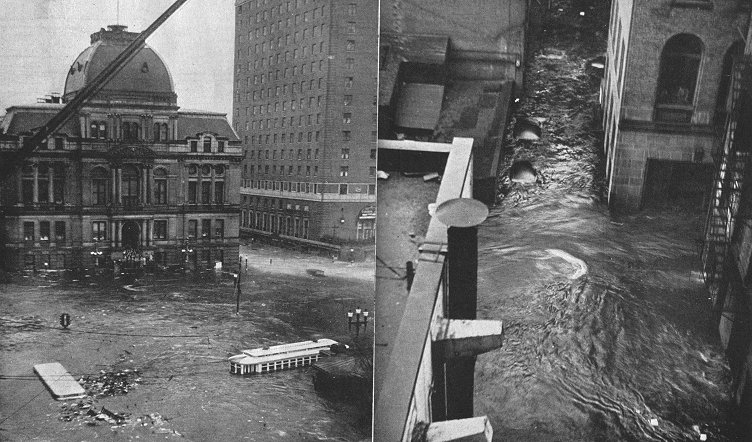

“The water had spun it around like a stone on the beach, using it like a drill. “I remember going out onto the porch in the wind and leaning into it at a 45 degree angle.” Exploring the wrecked town the next day, Gifford recalled seeing a car that the storm had had its way with. Prosser Gifford’s memories were also colored by his youth at the time. The next day, “My father came up with a truck, loaded with boxes of fish.” Sam Cahoon delivered his load and then took his daughter back home to Woods Hole.

The city was under water.” One of the boys she was with “got hit with a sign blowing off a building, right in the head no less,” Cynthia recalled, adding, “but he made out all right.” The boy wasn’t injured. “So we went as far as we could down the hill, and there was water all over. We hopped over wires and branches and everything to get to our dormitory.” Hours later, some boys from the college suggested a tour to see the damage. This must have been the eye that we wandered into. “I was walking home from class with a friend and things were blowing all over the place.” Then, unexpectedly, “the sun began shining. It was fun,” she explained.Ĭynthia was studying business at Bryant College in Providence when the storm roared through. “It was bad, but we didn’t know it was bad. Frannie, a high school junior that year, described braving wicked winds to wade through floodwaters near the Veeder house on Albatross Street. Two daughters of fish market owner Sam Cahoon, Frannie Shepherd and Cynthia Smith, both of whom grew up in Woods Hole and still live here, had their own memories of the storm. Waves breaking over sea wall near the Fisheries, September 1938. “Water was going four or five knots right through downtown Woods Hole.” “So it came up over the land,” said Gifford. “People were down along the shore,” Gifford explained, “watching their boats and docks as they blew in.” As a result, many were unprepared when “the real water came at them from behind.” Hurricane winds had plowed a massive storm surge into Buzzards Bay, where it piled up with no place to go. “You couldn’t design a worse storm for this area.” Wind and waves thundered in from the southeast, straight down the pipe through the one unprotected compass direction into Great Harbor. “The water rose 20 feet in 20 minutes,” remembers Prosser Gifford of Penzance Point, who was nine years old when the storm hit that September. This was certainly the case in Woods Hole.

Waters rose too fast, roads were cut off, escape quickly became impossible. Even if newspapers on the morning of the 21st had found room alongside headlines about Hitler’s manhandling of Czechoslovakia to mention the onrushing storm, many residents would have struggled to stay out of its way. The ‘38 storm reached a forward velocity of 70 mph - the fastest traveling speed ever recorded for a hurricane. The fact that bigger storms have made landfall without causing nearly so much loss of life - 380 died that day in Rhode Island alone - was not only because of the lack of warning. For Woods Hole and Falmouth the losses - in life, limb and property - were proportionately worse by far than in any storm since. How bad was it? As the category 3 hurricane tore a path across Long Island, Rhode Island, Connecticut, Massachusetts, Vermont and into Quebec, it left 63,000 homeless, took almost 700 lives, wiped entire seacoast towns off the map and downed an estimated 250 million trees - including one third of Vermont’s sugar maples and half of New Hampshire’s white pines. Few if any had experienced the brutal 1869 Saxby Gale, let alone the 1821 Norfolk and Long Island Hurricane or the Great Colonial Hurricane of 1636. In ‘38, before computers and satellites, we relied more on instinct, and instinct relied on experience. 1938 was the end of New England’s hurricane innocence, when a nascent but still hidebound national weather bureau was content to ignore junior re- searcher Charlie Pierce’s correct storm track prediction because, in a nutshell, “hurricanes never do that” - they “always” curve out to sea. The storm also had no name because no one expected it. It had no name because storms didn’t then, but it’s picked up a few catchy handles in the meantime: “The Yankee Clipper”, “The Long Island Express”, “The Great New England Hurricane”, or the one we hear most often today: “The Hurricane of ‘38”. 75 years ago this September a hurricane with no name slammed into our shores and wreaked more devastation than any storm had in 70 years - or has since.


 0 kommentar(er)
0 kommentar(er)
